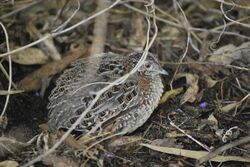Abrolhos painted buttonquail
Topic: Biology
 From HandWiki - Reading time: 3 min
From HandWiki - Reading time: 3 min
| Abrolhos painted buttonquail | |
|---|---|

| |
| Scientific classification | |
| Domain: | Eukaryota |
| Kingdom: | Animalia |
| Phylum: | Chordata |
| Class: | Aves |
| Order: | Charadriiformes |
| Family: | Turnicidae |
| Genus: | Turnix |
| Species: | |
| Subspecies: | T. v. scintillans
|
| Trinomial name | |
| Turnix varius scintillans (Gould, 1845)
| |
The Abrolhos painted buttonquail (Turnix varius scintillans) is a subspecies of the painted buttonquail endemic to the Houtman Abrolhos. It is common on North Island, and also occurs on other islands of the Wallabi Group, namely East Wallabi, West Wallabi, Seagull and Pigeon Islands.[1]
Taxonomy
The first recorded sighting of the bird by Europeans was during the third voyage of HMS Beagle. On 22 May 1840, the crew of the ship landed at North Island, which John Lort Stokes described thus:[2]
"The island was about a mile across, and nearly circular. It was surrounded by a range of hills, with a flat in the centre, covered with coarse grass, where a great many quails were flushed, affording good sport, but not a single wallaby."
Five years later, the subspecies was formally published by John Gould.[3]
Description
It lives amongst dunes and sand flats covered with Spinifex, saltbush and samphire, and avoids areas of limestone pavement. It obtains food such as insects and seeds by scratching in the surface soil, but also will collect scraps it can find.[4] It breeds from April to October. Its nest is a scrape in loose soil about ten centimetres wide and two centimetres deep, beneath vegetation. The species matures at one year and has a longevity of nine years.[1]
Conservation status
In 2003 it was assessed as "fauna which is rare, or likely to become extinct" under the WA Wildlife Conservation Act 1950. Islands where it breeds are considered to have a high conservation value. Rats and cats have been introduced to the ecosystem which may pose a threat to the population.[5]
A 2018 study ranked it fifth in a list of Australian birds most likely to go extinct.[6]
(As of July 2022) the subspecies is listed as "vulnerable" under the federal EPBC Act (last updated 16 July 2000, due for reassessment 30 October 2022), and endangered under the Biodiversity Conservation Act 2016 (WA).[7]
References
- ↑ 1.0 1.1 Storr, G. M.; Johnstone, R. E.; Griffin, P. (1986). "Birds of the Houtman Abholhos, Western Australia". Records of the Western Australian Museum (Supplement No. 24).
- ↑ Stokes, John Lort (1846). Discoveries in Australia, Volume 2. London: T. and W. Boone. https://www.gutenberg.org/ebooks/12146. Retrieved 2007-11-18.
- ↑ Gould, John (1844). "May 27, 1845". Proceedings of the Zoological Society of London (Academic Press, [etc.]) pt.12-15 (1844-1847): 62. https://www.biodiversitylibrary.org/page/12862558#page/276/mode/1up. Retrieved 17 November 2023.
- ↑ Storr, G. M. (1965). "The physiography, vegetation and vertebrate fauna of the Wallabi Group, Houtman Abrolhos". Journal of the Royal Society of Western Australia 48: 1–14.
- ↑ Inventory of the Land Conservation Values of the Houtman Abrolhos Islands (Report) (Fisheries Management Paper No. 151 ed.). Department of Fisheries, Government of Western Australia. October 2003. ISSN 0819-4327. http://www.fish.wa.gov.au/Documents/management_papers/fmp151.pdf. Retrieved 20 March 2020.
- ↑ Geyle, Hayley M.; Woinarski, John C. Z. et al. (20 April 2018). "Quantifying extinction risk and forecasting the number of impending Australian bird and mammal extinctions". Pacific Conservation Biology 24 (2): 157–167. doi:10.1071/PC18006. ISSN 2204-4604. https://www.publish.csiro.au/pc/PC18006. Retrieved 11 July 2022. PDF
- ↑ "Petauroides volans - Greater Glider (southern and central)". Department of Climate Change, Energy, the Environment and Water, Australian Government. http://www.environment.gov.au/cgi-bin/sprat/public/publicspecies.pl?taxon_id=82451.
Wikidata ☰ Q4669562 entry
 |
 KSF
KSF
